A green tea smoothie is one of the tastiest ways to enjoy this drink, and today we are going to share 20 new recipes for you to try! Not only that, but we'll also share everything else you've ever wanted to know about green tea smoothies, so don't miss the rest of this post.
Green tea is one of the healthiest forms of hot tea. Not only does it help with general health, but it also tastes delicious. Green tea also comes in a variety of forms, such as tea bags, loose leaves, and matcha.
Each form has a slightly different taste, giving options for those who enjoy the taste of green tea and the health benefits it provides. Green tea smoothies are also exceptionally delicious and are perfect for those who enjoy a little sweetness with their tea. The best part about making these delicious treats is that you can get creative with the process to make them your own creation.
This post is quite long, so here is a list of contents so that you can jump to your desired area without refreshing the page. So, pick which section you like and get started:
- Basic of Green Tea Smoothie
- Approach 1 - Matcha Green Tea Smoothie
- Approach 2 - Loose Leaf Green Tea Smoothie
-
There's too Many Options. Which One is Right for Me?
- Actual Green Tea Smoothie Recipe
- More about Green Tea Smoothie
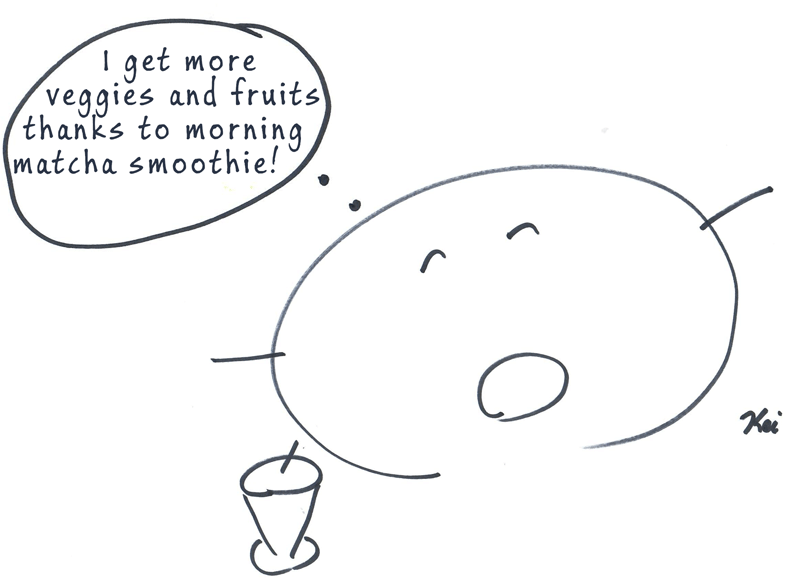
Basics of Green Tea Smoothie
There are mainly two ways to make green tea smoothie:
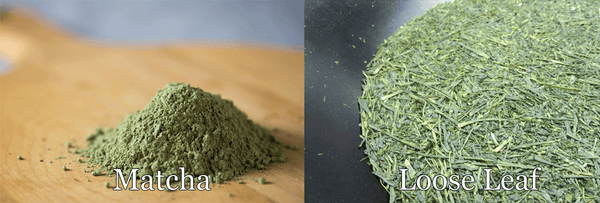
In this article, I will show you the tips and tricks of each approach and the recipe for each. Read on or bookmark this page, as this is the ultimate guide to making a green tea smoothie.
Approach 1: Matcha Green Tea Smoothies: The Quickest Green Tea Smoothie There Is!
Matcha is a ground and powdered form of regular green tea leaves that are grown in the shade away from direct sunlight. It more closely resembles protein powder or coffee grounds than green tea leaves, but the matcha retains all of the healthy vitamins and minerals from the tea leaves. Making smoothies using matcha is a simple process, and with just a few ingredients, you can have a delicious smoothie packed with nutrients.
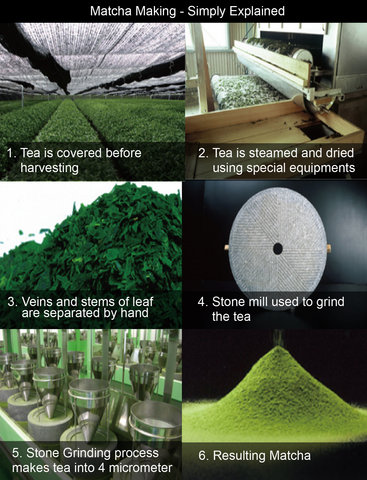
Matcha is ground and powdered Japanese green tea. A type of tea called tencha is grown in shade prior to harvesting.
Making matcha green tea smoothies is simple. In fact, it is so simple that it only takes a few minutes of your time each day to make this delicious treat. You simply scoop the ingredients you desire and mix in the appropriate amount of matcha, and you will have the perfect green tea smoothie for your taste and preference.
There are several pros to using matcha in your green tea smoothie. For one, it is much faster than steeping your tea leaves or grinding them into a powder. The process is already finished for you. This makes getting your smoothie that much faster! Another pro of using matcha is the simplicity of the powder.
For novice green tea drinkers, matcha might be the perfect choice to make their smoothies. It is a simple scoop instead of learning to grind your own. A con of this process, however, is the price.
Matcha can be pricey in certain places. For some, it is much more cost-effective to steep their own green tea leaves or grind them at home. Another downfall of using matcha is the process it takes to grow the leaves that matcha is made from.
Because they are grown in the shade throughout the entirety of the plant's life, it takes much longer to grow the green tea leaves that matcha is made from. This longer time span is what gives matcha its delicious and different flavor, but it is also the reason matcha can be quite pricey.
Using Matcha with Milk or Soy Milk
Matcha and milk go very well. Surprisingly, matcha goes very well with soy milk too. I personally do not like soy milk's smell, but I know soy milk is healthy. Matcha's aroma hides the smell of soy milk so well that I cannot smell that "row" smell of soy anymore when I add matcha. This has been a good trick for me to drink soy milk from a health perspective.
If you like this approach, click here to jump to the 10 Matcha Green Tea Smoothies Section.
Approach 2: Loose Leaf Green Tea Makes an Amazing and Delicious Smoothie!
There are two ways to use loose green tea leaves to make a smoothie. Both ways create a different taste and texture, but both ways are not difficult to learn. Either way is just as effective as the other, but depending on your preference, you can choose which is better or easier for you. The two ways to prepare your green tea for the smoothie are as follows:
Steep your green tea leaves just as you would if you were to drink them straight. Allow it to cool slightly, then pour it into the blender on top of your other ingredients.
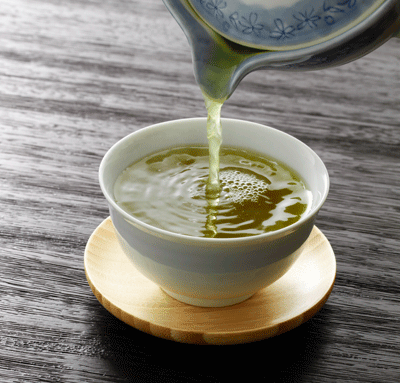
Grind your green tea leaves until they are finely powdered—or powdered to your preference. A coffee grinder is a good and easy option for grinding green tea.
Grinding regular loose leaf green tea does not make matcha since matcha is made of a specific tea type called "Tencha." This is different from the loose leaf green tea you usually get from the store. It is commonly called "Konacha" in Japan. Then, place the ground tea leaves into the blender to be made into a smoothie.
Make Your Own Matcha
If you want to make your own matcha, the Sharp TE-T56U-GR Tea-Cere Matcha Tea Maker allows you to grind green tea the way you traditionally would using a stone mill. This machine uses ceramic to mimic the traditional stone mill. Please note that you need to use a specific type of green tea called "Tencha" in order to get the resulting matcha. I wrote a whole review article about this product, which you can find here.
Either process makes delicious green tea smoothies. Once your tea is prepared, you can add the same ingredients as your matcha smoothie or get creative and use your own experiment.
A pro of this process is the cost-effectiveness of using loose tea leaves. The loose tea isn't as costly as matcha, and it is easier to find in stores across the United States.
A con of using loose tea leaves is their timeliness. It takes longer to steep the tea or grind the leaves than it does to simply scoop matcha.
If you like this approach, click here to jump to the Loose Leaf Green Tea Smoothie Section.
Which Option Is Right For Me?
That's a great question. How do you choose which method is right for you?
If you are new to green tea, it might be easier to purchase matcha to make your smoothies. The health benefits are the same, but the process is a bit simpler than using loose leaves.
If you are concerned about cost, it might be a better choice to go with the loose leaves.
What if you are unable to grind the loose leaves? Then you might consider steeping the leaves or purchasing matcha for your smoothies.
If time is a concern, then you might choose to use matcha for your tea. If you already have loose leaves in your kitchen, then you might consider either steeping or grinding. Your taste preferences can also influence your decision.
Matcha Green Tea Smoothie Recipe
1. Quick Green Smoothie
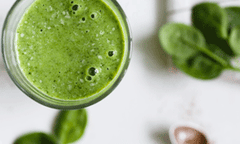
When green tea is combined with spinach, the health benefits are tremendous and varied. Spinach contains vitamins and iron. The addition of bananas brings some much-needed potassium to this recipe, and the grapes give the smoothie some delicious sweetness.
- 2 teaspoons of matcha green tea powder
- 2 cups of milk or water
- 1 cup of ice
- 1 cup of baby spinach leaves
- 2 cups of frozen green grapes and
- 1 frozen banana
Step 1: Before you put anything else, first put matcha.
Matcha is so powdery that if you put it at the end, it tends to fly out and stick to the side of the blender.
Step 2: You put the rest of them in and add a cup of ice. If you use ice, you have to make sure that your blender is capable of crushing ice. (Some blenders are not meant to be used for ice, and it will break. If your blender is not meant for ice, you skip the ice. Bananas and grapes are frozen anyway, so it still tastes good.)
Generally speaking, blenders with 1000–1500 watts are suitable for breaking the ice.
Blender I am using in the video: Vitamix (works well with ice): https://bit.ly/MatchaSmoothieBlender
Step 3: Add some milk or plain yogurt.
Step 4: Add any kind of fruit here. I found that matcha and banana go so well together. So if you use them as the main ingredients, you cannot go wrong. Just add other fruits to them.
Step 5: Turn the blender on.
Watch me make this smoothie with ChaCha!
I made a video making this particular smoothie. Click below to watch the video.
Video Length: 3 minutes 21 seconds
Click to Subscribe to my YouTube Channel
2. Refreshing Peach Green Tea Smoothie
Peaches provide the body with fiber, antioxidants, and a whopping ten vitamins. The banana will give the body a healthy dose of potassium.
- 1 frozen banana
- 1 large peach, pitted, skinned, and cut into large chunks
- 2 teaspoons of matcha green tea powder
- 1 tbsp of maple syrup
Combine all of the ingredients in a blender and blend until smooth.
3. Banana and Peanut Butter Green Tea Smoothie
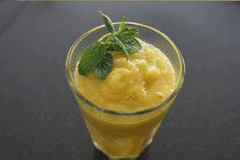
Bananas offer high levels of potassium, an essential electrolyte. Peanut butter gives the body a protein boost.
- 1 frozen banana
- 1/2 cup of milk
- 2 tbsp. of peanut butter
- 1 tbsp of maple syrup
- 2 teaspoons of matcha green tea powder
Combine all of the ingredients in a blender and blend until smooth.
4. Apple, Lemon and Ginger Green Tea Smoothie
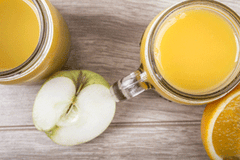
Ginger acts as an anti-inflammatory for the digestive system, while lemon's antibacterial properties clean out the body.
- 1 frozen apple
- 1 2-inch chunk of ginger, peeled and loosely chopped
- 2 tbsp. of lemon juice
- 1 tbsp. of honey
- 2 teaspoons of matcha green tea powder
5. Blueberry and Flaxseed Green Tea Smoothie
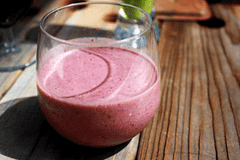
Blueberries provide the body with high levels of Vitamin C. Flaxseed is full of fiber to aid your digestive system.
- 1 tbsp of flaxseed
- 1 cup of frozen blueberries
- 1/2 cup of Greek yogurt
- 1 tbsp. of honey
- 2 teaspoons of matcha green tea powder
Combine all of the ingredients in a blender and blend until smooth.
7. Tropical Pineapple Green Tea Smoothie
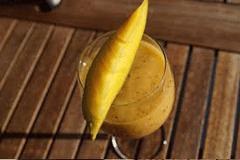
Pineapple is full of essential electrolytes that will keep your body feeling great all day.
- 1 cup of pineapple chunks
- 2 tbsp. of lemon juice
- 1/2 cup of coconut milk
- 1 tbsp. of honey
- 1 cup of ice
- 2 teaspoons of matcha green tea powder
Combine all of the ingredients in a blender and blend until smooth.
8. Green Goddess Green Tea Smoothie
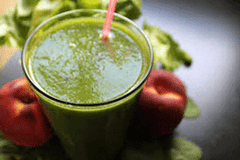
Avocado gives the body essential fatty acids, while banana provides the body with a daily serving of potassium.
- 1 avocado, peeled, pitted, and cut into quarters
- 2 tbsp. of lemon juice
- 1 frozen banana
- 1 tbsp. of honey
- 1/2 cup of ice
- 2 teaspoons of matcha green tea powder
Combine all of the ingredients in a blender and blend until smooth.
9. Super Green Smoothie
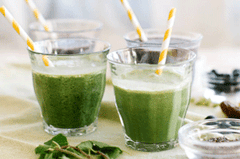
The high amount of greens in this recipe will give your body loads of iron and vitamin A.
- 1 cup of baby spinach leaves
- 1/2 cup of baby kale leaves
- 6 large fresh mint leaves
- 1 frozen banana
- 1 tbsp of maple syrup
- 2 teaspoons of matcha green tea powder
Combine all of the ingredients in a blender and blend until smooth.
10. Orange and Mango Green Tea Smoothie

Oranges offer the body high levels of vitamin C, while bananas provide potassium.
- 3/4 cup of freshly squeezed orange juice
- 1 cup of frozen mango chunks
- 1 frozen banana
- 2 teaspoons of matcha green tea powder
Combine all of the ingredients in a blender and blend until smooth.
11. Berry & Green Tea Smoothie
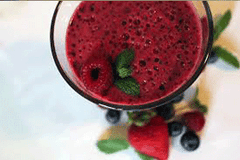
Berries are packed with antioxidants and add delicious sweetness to this recipe.
- 1 cup of frozen assorted berries
- 1 tsp of lemon juice
- 1 frozen banana
- 1/2 cup of Greek yogurt
- 1/2 cup of brewed green tea that has been refrigerated for one hour
Combine all of the ingredients in a blender and blend until smooth.
12. Apple Pie Green Tea Smoothie
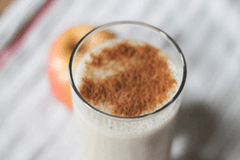
This dessert-like smoothie is full of protein and fiber.
- 1/2 cup of rolled oats
- 1 apple, peeled, pitted, and cut into chunks
- 1 tsp of vanilla extract
- 1/2 cup of Greek yogurt
- 1/2 cup of ice
- 1/2 cup of brewed green tea that has been refrigerated for one hour
Combine all of the ingredients in a blender and blend until smooth.
13. Strawberry Banana Green Tea Smoothie
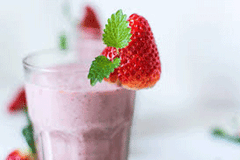
Packed with antioxidants and potassium, this smoothie is a sweet treat.
- 1 cup of frozen strawberries
- 1 frozen banana
- 1/2 cup of Greek yogurt
- 1/2 cup of ice
- 1/3 cup of brewed green tea that has been refrigerated for one hour
Combine all of the ingredients in a blender and blend until smooth.
14. Carrot and Ginger Green Tea Smoothie
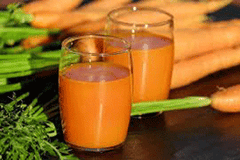
Carrots are full of nutrients like beta-carotene and fiber. Ginger aids the digestive system.
- 1 peeled and chopped carrot
- 1 pear, peeled, pitted, and roughly chopped
- 1 2-inch chunk of ginger, peeled and chopped
- 1/2 cup of ice
- 1/3 cup of brewed green tea that has been refrigerated for one hour
Combine all of the ingredients in a blender and blend until smooth.
15. Apple and Chia Seed Green Tea Smoothie
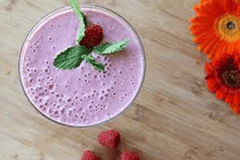
Chia seeds are full of protein and fiber. Apples provide vitamin C as well as extra sweetness.
- 2 tbsp of chia seeds
- 1 apple, peeled, pitted and roughly chopped
- 1 tsbp of lemon juice
- 1 cup of ice
- 1/2 cup of plain yogurt
- 1/2 cup of brewed green tea that has been refrigerated for one hour
Combine all of the ingredients in a blender and blend until smooth.
16. Papaya and Strawberry Green Tea Smoothie
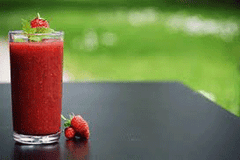
Strawberries give the body antioxidants, while papaya provides enzymes that aid in digestion.
- 1 cup of frozen papaya chunks
- 1 cup of frozen strawberries
- 1 ripe banana
- 1 tbsp. of honey
- 1/2 cup of brewed green tea that has been refrigerated for one hour
Combine all of the ingredients in a blender and blend until smooth.
17. Pear and Almond Green Tea Smoothie

Almonds provide lots of protein for the body and are full of vitamins. This smoothie will leave you feeling satisfied for hours.
- 1/2 cup of almonds
- 1 frozen pear, peeled and pitted
- 1 frozen banana
- 1/2 cup of brewed green tea that has been refrigerated for one hour
Combine all of the ingredients in a high-powered blender, like a Vitamix, and blend until smooth.
18. Island Green Tea Smoothie
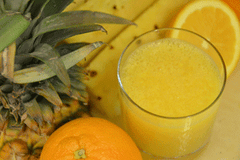
These tropical ingredients give the body fiber and vitamin C.
- 1/2 cup of frozen mango chunks
- 3/4 cup of pineapple chunks
- 1 frozen banana
- 1 tbsp. of honey
- 1/3 cup of coconut milk
- 1/2 cup of brewed green tea that has been refrigerated for one hour
Combine all of the ingredients in a blender and blend until smooth.
19. Raspberry, Lime and Mint Green Tea Smoothie

This refreshing smoothie offers antioxidants and vitamin C.
- 1 cup of frozen raspberries
- 3 tbsp. of lime juice
- 3 tbsp of chopped fresh mint leaves
- 1 tbsp. of honey
- 1/2 cup of orange juice
- 1/2 cup of ice
- 1/3 cup of brewed green tea that has been refrigerated for one hour
Combine all of the ingredients in a blender and blend until smooth.
20. Chocolate Banana Green Tea Smoothie
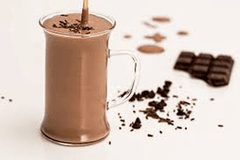
Decadent chocolate gives the body a boost of magnesium.
- 1/4 cup of cocoa powder
- 1 1/2 frozen bananas
- 2 tbsp. of almond butter
- 1 tbsp. of honey
- 1/2 cup of milk
- 1/2 cup of ice
- 1/3 cup of brewed green tea that has been refrigerated for one hour
Combine all of the ingredients in a blender and blend until smooth.
Tip for Making Tastier Green Tea Smoothie
Use Covered Green Tea
For a loose leaf green tea smoothie, I liked to use covered Japanese green tea, which has the best health benefits and a bright emerald green color. Covered green tea has a brighter color, which makes the smoothie look better. Click here to get covered in Japanese green tea.
Use Mixer Good for Ice Crushing
If you are using a blender that can crush ice (such as a Vitamix), add a cup of crushed ice in addition to the ingredients for a better taste. Please note that a regular mixer usually does not crush ice, so you have to get a mixer that can crush ice.
I use a Vitamix; this is the company that makes mixers for Frappuccino® at Starbucks and Jamba Juice. Vitamix is a bit pricier than other mixers, but it’s very durable and lasts a long time. Click here to get a Vitamix from Amazon.
Use Culinary Grade Matcha
There are different types of matcha available on the market. The two main types you find are culinary grade matcha (a.k.a. cooking matcha) and ceremonial grade matcha. Culinary Grade is most often used for cooking, such that the matcha is mixed with other recipes to make smoothies, cookies, cakes, etc.
This is the type used by most retailers, such as Starbucks, when they say matcha in their product names. Ceremonial-grade matcha is usually more expensive and uses younger tea leaves, whose stems and veins are removed in the process of making them.
Ceremonial Grade is used in tea ceremonies, and many tea masters suggest only mixing it with hot water for "ceremonial" purposes. I personally think that both taste good, but culinary-grade matcha usually has a stronger flavor, which comes out better in smoothies and is more economical.
Bonus - Poll At Green Tea Club Facebook Group
We did a poll in our Green Tea Club private Facebook group, and here are snapshots of what people like. Join our private Facebook group to participate in the future poll; it is fun. Click here to join.
Looking for More Ways to Enjoy Green Tea Smoothie? Here are Link to Other Great Green Tea Smoothie Recipes
There are many great great Green Tea Smoothie Recipe out there, and here are list of my favorites.
-
Green Tea Smoothie with Banana with Video by Just One Cookbook
This is my favorite blog; she creates amazing videos for many Japanese recipes. This one also has a video on how to make a green tea smoothie with banana. -
Exotic Green Smoothie, Dairy-Free Coconut Matcha Smoothie by Jen Yee
This is a recipe from Food Republic that I personally like. The recipe is from Jen Yee, an award-winning chef at NYC's Lafayette Grand Cafe and Bakery. -
Peach Green Tea Smoothie and Green Tea and Almond Smoothie by Janette's Healthy Living
My other favorite recipe blog features two green tea smoothie recipes. -
Mango Green Tea Smoothie by Cooking Classy
Another lovely recipe blog with beautiful images -
Matcha Mango Pineapple Smoothie by Teacups & Things
Her blog and recipes are beautifully done with nice images. I love her simple style and clean blog. -
Mint and Green Tea Smoothie by Kitchen Konfidence
Brandon is a photographer and cook; his recipes are very personal, and his passion for photography shows in each recipe. -
Raspberry Green Tea Smoothie by Recipe Runner
The image of this recipe is so cute! Dinae's love of cooking and running show a very unique perspective on how she writes about her recipes. -
30 Fat-Burning Detox Green Tea Smoothie Recipes
They have 30 different links specific to detoxing with a green tea smoothie.
Conclusion
Green tea is packed with healthy vitamins and minerals. The nutrients in the tea have a wide variety of health benefits, including promoting healthy weight loss. The green tea smoothies are just another wonderful way to enjoy green tea without simply drinking it. You can add a touch of sweetness to your tea or add fruit for more of a breakfast smoothie. You can even enjoy them for dessert.
Either way, green tea smoothies are simple to make, but they can brighten even the dreariest of days. Get creative, experiment with your smoothie, and make your green tea smoothies personal for you.
This article was originally published in 2017 and was updated in 2021.
• Disclosure: I only recommend products I would use myself, and all opinions expressed here are my
own. This post may contain affiliate links that I may earn a small commission at no additional cost to you.
The commission also supports us in producing better content when you buy through our site links.
Thanks for your support.
- Kei and Team at Japanese Green Tea Co.
Get Free Bonus Books




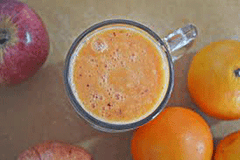


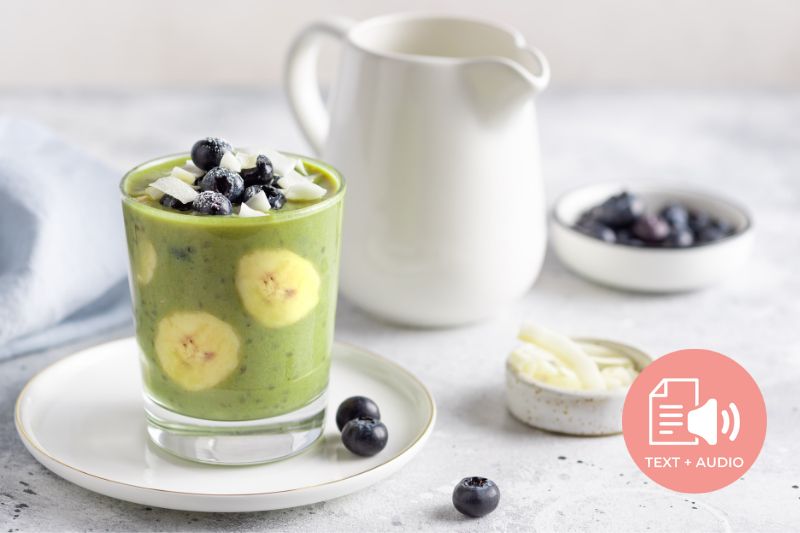
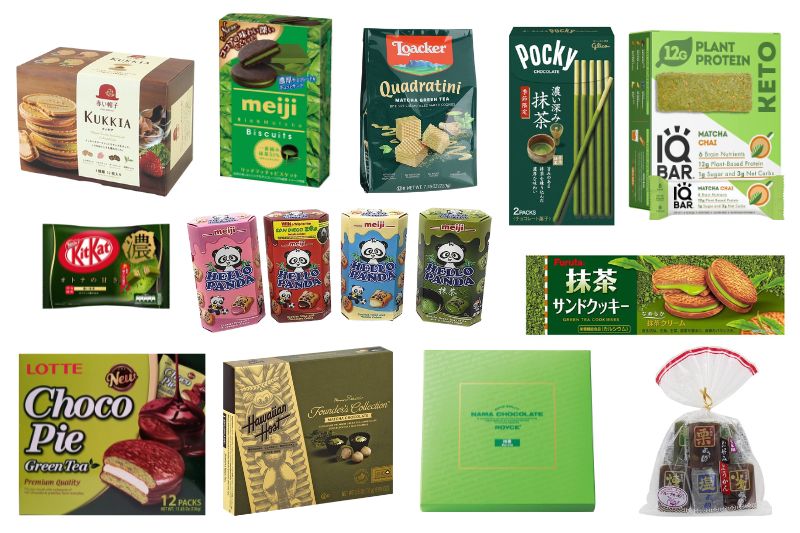
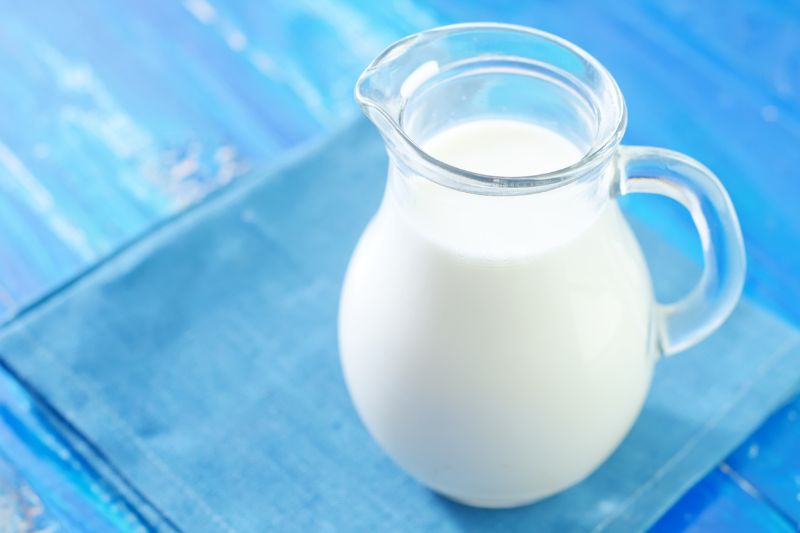



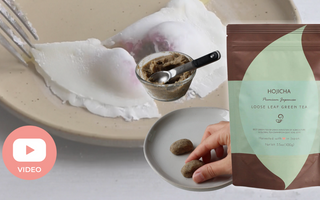
These recipes are delicious! So yummy
Thank you very much Tara!
OMG These are the BEST! It seems the options with green tea are endless. This excites me to no end!